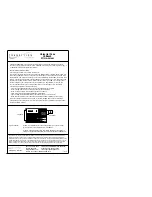
GX5500S
Page 8
5.4 COAXIAL
CABLE
VHF antennas are connected to the transceiver by means of a coaxial cable
±DVKLHOGHGWUDQVPLVVLRQOLQH&RD[LDOFDEOHLVVSHFL¿HGE\LW¶VGLDPHWHUDQG
construction.
For runs less than 20 feet, RG-58/U, about 1/4 inch in diameter is a good
choice. For runs over 20 feet but less than 50 feet, the larger RG-8X or
RG-213/U should be used for cable runs over 50 feet RG-213/U should be
used. For installation of the connector onto the coaxial cable refer to the
¿JXUHEHORZ
7RJHW\RXUFRD[FDEOHWKURXJKD¿WWLQJDQGLQWR\RXUERDW¶VLQWHULRU
you may have to cut off the end plug and reattach it later. You can do
this if you follow the directions that come with the connector. Be sure
to make good soldered connections.
5.5
EMERGENCY (CHANNEL 16 USE)
Channel 16 is known as the Hail and Distress Channel. An emergency may
EH GH¿QHG DV D WKUHDW WR OLIH RU SURSHUW\ ,Q VXFK LQVWDQFHV EH VXUH WKH
transceiver is on and set to CHANNEL 16. Then use the following proce-
dure:
3UHVV WKH PLFURSKRQH SXVKWRWDON VZLWFK DQG VD\ ³
Mayday
,
Mayday
,
Mayday
. This is , , ” (your vessel’s name).
7KHQUHSHDWRQFH³
Mayday
, ” (your vessel’s name).
3. Now report your position in latitude/longitude, or by giving a true or
magnetic bearing (state which) to a well-known landmark such as a navi-
gation aid or geographic feature such as an island or harbor entry.
([SODLQWKHQDWXUHRI\RXUGLVWUHVVVLQNLQJFROOLVLRQDJURXQG¿UHKHDUW
attack, life-threatening injury, etc.).
5. State the kind of assistance your desire (pumps, medical aid, etc.).









































